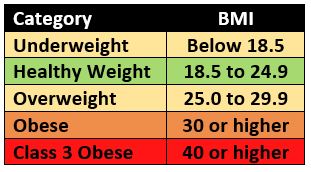Most major US medical organizations recommend measuring body mass index (BMI) and waist circumference (WC) at annual visits to screen for overweight and obesity. They also recommend these measures be done more frequently for those who are already overweight or obese. These organizations include:
- US Health and Human Services, National Institutes of Health, Heart, Lung, and Blood Institute1
- US Preventive Services Task Force2
- Obesity Society3
- American Heart Association3
- American College of Cardiology3
- American Association of Clinical Endocrinologists4
- American College of Endocrinology4
- Academy of Nutrition and Dietetics5
Overweight and obesity raise the risk of many serious health conditions.4,6-15 Obese adults have at least a 20% higher risk than normal weight adults of death from cardiovascular disease and all other causes.7
Body Mass Index (BMI)
A simple measure of overweight and obesity were most recently defined in the 2013 guidelines for the management of overweight and obesity in adults by The Obesity Society and American College of Cardiology/American Heart Association (ACC/AHA).9 Overweight is defined as a body mass index (BMI) of 25.0 to 29.9 and obesity as a BMI of ≥30 [Strong Recommendation (Level B)]. BMI is a measure that adjusts body weight for height.
In the US, about 70.7% of adults age 20 or older are overweight (BMI ≥25) (age-adjusted prevalence).16 Of these, 39.8% are obese (BMI ≥30). These estimates are based on an analysis of the 2015 – 2016 US National Health and Nutrition Examination Survey (NHANES).
An Adult BMI Calculator is available from the US Centers for Disease Control and Prevention.17 It is for people 20 years old or older.
Waist Circumference (WC)
Another factor considered when determining that a person is overweight and obese is central (abdominal) obesity. WC is a simple measure of central abdominal obesity. It is strongly associated with a raised risk of diabetes mellitus, metabolic syndrome, coronary heart disease, high blood pressure, and dyslipidemia.1,3,4,9,18,19 When a person who is overweight (≥25 BMI) also has a WC above the healthy cut-off for their gender, their risk of obesity-related disease increases. People with a BMI ≥35 are usually above healthy WC so this measurement is not used to predict additional risk.1,2,4 However, it can aid in tracking weight reduction in these people.
The current WC cut-offs above which adults in the US and Canada are considered at higher risk of obesity-related disease are:3,4,9
- Men: >102 cm (>40 in)
- Women: >88 cm (>35 in)
The 2016 AACE/ACE Obesity Clinical Practice Guidelines recommend using different cut-off points for adults with South Asian, Southeast Asian, and East Asian ethnicity of ≥85 cm for men and ≥74 to 80 cm for women.4 A table recommended for world-wide ethnic specific WC cut-offs is found in the International Diabetes Federation (IDF) Worldwide Definition of the Metabolic Syndrome.20
References
- Managing overweight and obesity in adults: systematic evidence review from the Obesity Expert Panel. Bethesda, MD: US Department of Health and Human Services, National Institutes of Health, National Heart, Lung, and Blood Institute; 2013.
- U. S. Preventive Services Task Force. Behavioral weight loss interventions to prevent obesity-related morbidity and mortality in adults: Us preventive services task force recommendation statement. JAMA 2018; 320 (11): 1163-1171.
- Jensen MD, Ryan DH, Apovian CM, et al. 2013 AHA/ACC/TOS guideline for the management of overweight and obesity in adults: a report of the American College of Cardiology/American Heart Association Task Force on Practice Guidelines and The Obesity Society. Circulation 2014; 129 (25 Suppl 2): S102-138.
- Garvey WT, Mechanick JI, Brett EM, et al. American Association of Clinical Endocrinologists and American College of Endocrinology comprehensive clinical practice guidelines for medical care of patients with obesity. Endocr Pract 2016; 22 Suppl 3: 1-203.
- Jortberg B, Myers E, Gigliotti L, et al. Academy of Nutrition and Dietetics: standards of practice and standards of professional performance for registered dietitian nutritionists (competent, proficient, and expert) in adult weight management. J Acad Nutr Diet 2015; 115 (4): 609-618.e640.
- Benjamin EJ, Virani SS, Callaway CW, et al. Heart disease and stroke statistics - 2018 update: a report from the American Heart Association. Circulation 2018; 137 (12): e67-e492.
- Borrell LN, Samuel L. Body mass index categories and mortality risk in US adults: the effect of overweight and obesity on advancing death. Am J Public Health 2014; 104 (3): 512-519.
- Danaei G, Ding EL, Mozaffarian D, et al. The preventable causes of death in the United States: comparative risk assessment of dietary, lifestyle, and metabolic risk factors. PLoS Med 2009; 6 (4): e1000058.
- Expert panel report: guidelines (2013) for the management of overweight and obesity in adults. Obesity (Silver Spring) 2014; 22 Suppl 2: S41-410.
- Bhaskaran K, Douglas I, Forbes H, dos-Santos-Silva I, Leon DA, Smeeth L. Body-mass index and risk of 22 specific cancers: a population-based cohort study of 5.24 million UK adults. Lancet 2014; 384 (9945): 755-765.
- Guh DP, Zhang W, Bansback N, Amarsi Z, Birmingham CL, Anis AH. The incidence of co-morbidities related to obesity and overweight: a systematic review and meta-analysis. BMC Public Health 2009; 9: 88.
- Luppino FS, de Wit LM, Bouvy PF, et al. Overweight, obesity, and depression: a systematic review and meta-analysis of longitudinal studies. Arch Gen Psychiatry 2010; 67 (3): 220-229.
- Kodama S, Horikawa C, Fujihara K, et al. Quantitative relationship between body weight gain in adulthood and incident type 2 diabetes: a meta-analysis. Obes Rev 2014; 15 (3): 202-214.
- Strazzullo P, D'Elia L, Cairella G, Garbagnati F, Cappuccio FP, Scalfi L. Excess body weight and incidence of stroke: meta-analysis of prospective studies with 2 million participants. Stroke 2010; 41 (5): e418-426.
- Albanese E, Launer LJ, Egger M, et al. Body mass index in midlife and dementia: systematic review and meta-regression analysis of 589,649 men and women followed in longitudinal studies. Alzheimers Dement (Amst) 2017; 8: 165-178.
- Hales CM, Carroll MD, Fryar CD, Ogden CL. Prevalence of obesity among adults and youth: United States, 2015-2016. NCHS Data Brief 2017; (288): 1-8.
- Centers for Disease Control and Prevention. Healthy weight: adult BMI calculator. 2015; https://www.cdc.gov/healthyweight/assessing/bmi/adult_bmi/english_bmi_calculator/bmi_calculator.html. Accessed 28 Apr 2018.
- Ostchega Y, Hughes JP, Terry A, Fakhouri TH, Miller I. Abdominal obesity, body mass index, and hypertension in US adults: NHANES 2007-2010. Am J Hypertens 2012; 25 (12): 1271-1278.
- Lemieux S, Prud'homme D, Bouchard C, Tremblay A, Despres JP. A single threshold value of waist girth identifies normal-weight and overweight subjects with excess visceral adipose tissue. Am J Clin Nutr 1996; 64 (5): 685-693.
- Alberti KG, Zimmet P, Shaw J. Metabolic syndrome--a new world-wide definition. A Consensus Statement from the International Diabetes Federation. Diabet Med 2006; 23 (5): 469-480.


.png)